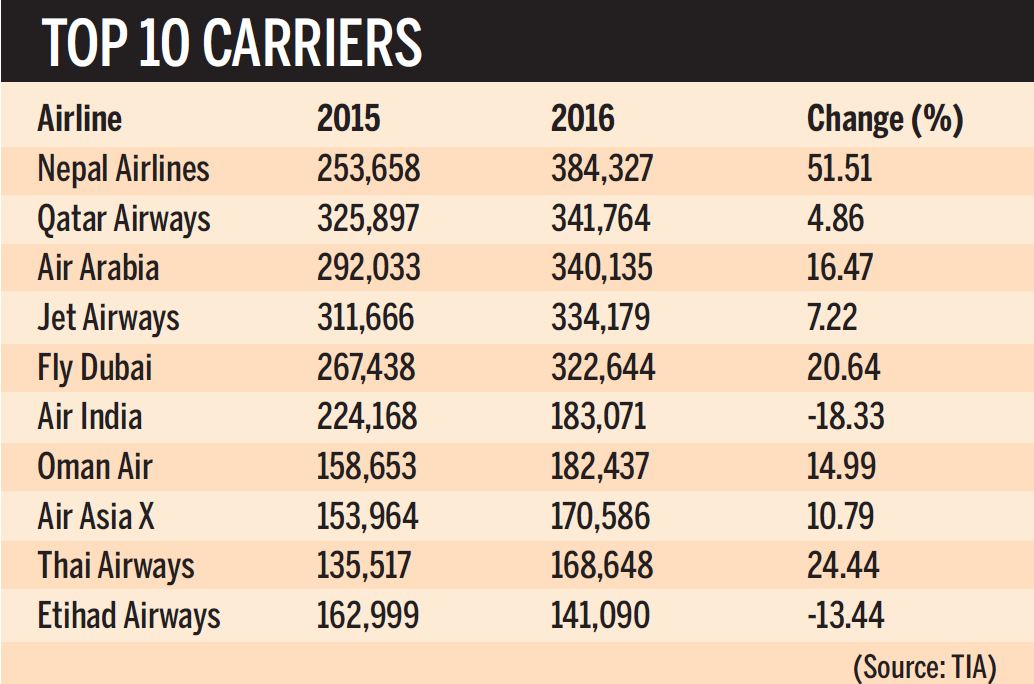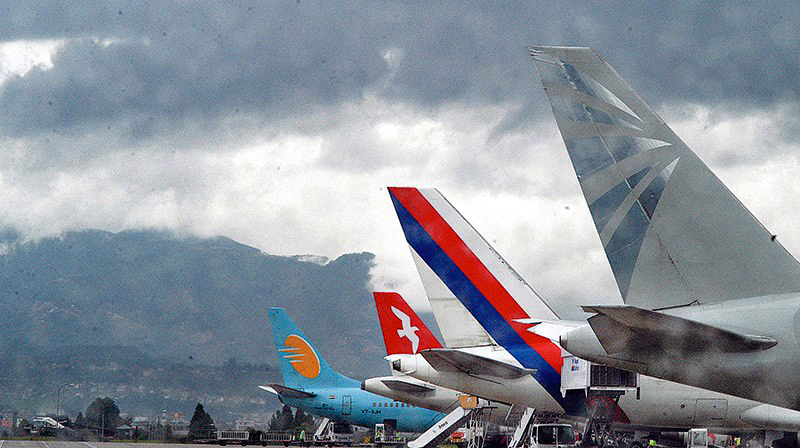Kathmandu, March 17, 2017: Tribhuvan International Airport (TIA) rebounded strongly from a slump caused by the April earthquake and jet fuel shortage caused by an Indian trade embargo in 2015 recording double-digit growth in passenger numbers in 2016.
Passenger traffic swelled 9.12 percent to 3.51 million in 2016, TIA data showed. The airport saw exactly the same number of travellers in 2014.
International air passenger traffic through TIA plunged 8.37 percent to a 13-year low of 3.21 million in 2015, as travellers stayed away due to the April earthquake.
Airport officials expect 2017 to be another big growth year as several airlines have launched new services, signaling a dramatic growth in tourist arrivals.
“There has been a dramatic growth in tourist numbers in the first quarter of this year, and it signals a boom year for Nepal’s tourism,” said Prem Nath Thakur, spokesperson for TIA. “The year 2017 could see more Chinese tourists, and arrivals from the southern neighbour are expected to increase too.”
Meanwhile, with passenger traffic continuing to grow, airlines have been expanding their connections. Nepal Airlines has added a number of destinations, while Nepal’s private carrier Himalaya Airlines has recently added an A320 to its fleet.
Himalaya is planning to add another aircraft within a few months and spread its network. Likewise, Tibet Airlines has applied to begin services to Nepal.
The aviation sector is flying high but infrastructural hurdles remain. “The increase in the number of planes, coupled with more foreign flights, has put immense pressure on aviation infrastructure,” said Thakur, adding that they had been receiving many proposals from airlines to increase frequency. “Due to the airport’s constraints, we are not able to fulfill their requests.”
He added that the airport was mulling to provide round-the-clock services due to the rise in demand. “There are some positive developments taking place.”
TIA is planning to bring into operation three remote parking bays at the eastern side of the airport by 2018. Likewise, two additional parking bays will be constructed by 2020.
Various drawbacks have delayed the completion of the first phase of the TIA improvement project. The completion date for the project has been pushed back to 2019 due to the tardiness of the previous contractor. After the completion of the project, TIA will be able to handle more than 5.85 million passengers annually and accommodate bigger aircraft.
A breakdown by airline shows that Nepal Airlines topped the list of carriers with the highest number of passengers. It flew 384,327 passengers, up 51.51 percent year-on-year. Doha-based Qatar Airways stood second with a passenger carriage growth of 4.86 percent. It flew 341,764 passengers during the review period. Low-cost carriers Air Arabia stood third with a strong 16.47 percent passenger growth. The carrier flew 340,135 passengers in 2016. India’s Jet Airways saw a 7.22 percent growth in passenger carriage to 334,179. Dubai-based low-cost carrier Fly Dubai saw a strongest 20.64 percent growth as it received 322,644 flyers. India’s national flag carrier Air India, however, saw its passenger growth plunge by 18.33 percent to 183,071 last year.
Oman Air saw their passenger numbers increase 14.99 percent to 182,437. Malaysian-based low-cost carrier Air Asia X saw a double-digit growth of 10.79 percent. It flew 170,586 passengers in the review period. However, Malaysia’s flag carrier Malaysia Airlines saw its passenger numbers plunge by 43.89 percent to 90,000.
TIA statistics show that Thai Airways passenger carriage growth jumped 24.44 percent to 168,648. Etihad Airways saw a negative passenger growth. It flew 141,090 passengers in 2016, down 13.44 percent.
Meanwhile, Hong Kong-based Dragon Air, now rebranded as Cathay Dragon, saw its passenger numbers grow 6.39 percent to 107,305 last year.
Chinese carriers Air China, China Eastern, China Southern and Sichuan Air saw their passenger carriage grow to a combined 180,858 during the review period, up 5.10 percent. Nepali carrier Himalaya Airlines, that started scheduled operations in May last year, carried 34,490 passengers in 2016.
According to TIA, 28 airlines, including three Nepali carriers that have been serving Nepal, made 27,118 flights in the Nepali skies—75 take-offs and landings daily.

By Sangam Prasain







